How To Create A Scale Model Of The Solar System
Have you ever wondered about the sizes of planets in the solar system or the distances between them? In this project, you will create your own scale model of the solar system by learning how to calculate scale distances, the relative sizes of planets, or both. Then, use beads and string, sidewalk chalk, or your own creative choice of materials to build a model you can explore – or maybe even wear!
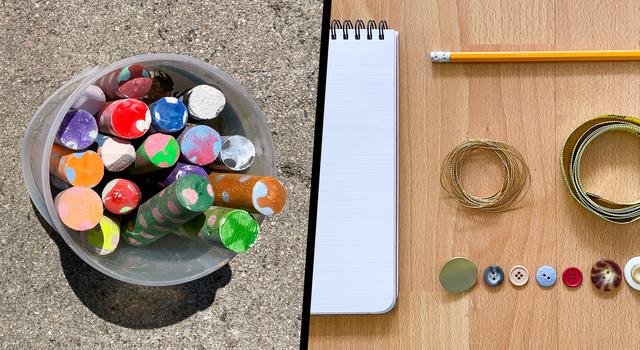
Materials
1. Learn about sizes and distances in our solar system
Distances in the solar system can be huge! The distance from the Sun to Neptune is nearly three billion miles (four billion kilometers). Because the distances between planets are so great, astronomers sometimes describe distances in terms of astronomical units (AU). One AU is equal to the average distance between the Sun and Earth, about 93 million miles (150 million kilometers). This allows scientists to describe and calculate distances more efficiently. For example, instead of saying, "Mars is 130 million miles from the Sun," scientists can say, "Mars is 1.5 AU from the Sun."
It's not just the distances between planets that are large. There are also huge differences in the size of each planet. Because of this, it can be difficult or even impossible to display both planet size and distance accurately, especially in smaller scale models like an image.
Watch this video about the size of planets and the distances between them to see how far they are from each other, how they differ in size, and how difficult it is to display both their size and distance accurately.
Watch en Español: Seleccione subtítulos en Español bajo el ícono de configuración. | Watch on YouTube
More solar system size and scale resources:
- Solar System Sizes and Distances reference guide – download PDF
- Solar System Trading Cards
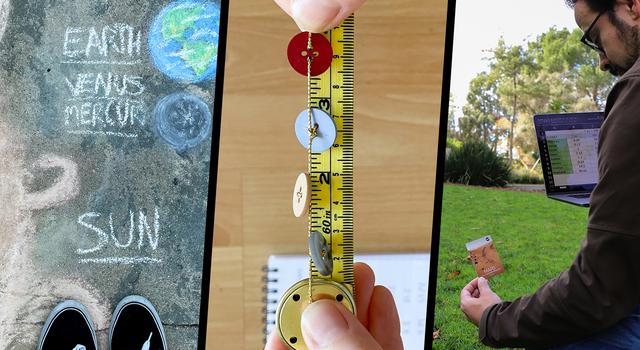
2. Decide what kind of model you want to build
Decide if you want your model to show scale planet sizes or the scale distances between planets. You can combine a planet-size model of one scale with a distance model of another scale. But if you want size and distance to be the same scale, you'll need to spread your model across at least half a mile! See Step 6 for instructions on building a combined size-and-distance model.
+ Expand image
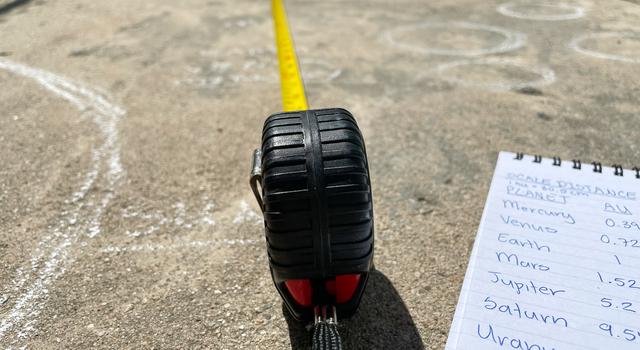
3. Choose where your model solar system will go
Pick a place to set up your solar system model. This could be across a bedroom wall, along the floor of a hallway or large room, outside in a yard, or down a sidewalk.
Keep your choice in mind as you calculate the size of planets and distances between them in the next steps. You'll need to have enough materials, and your model will have to fit within the place you choose.
Instructions for building a model out of beads and string, sidewalk chalk, or yard markers are included below, but you can use any materials or any space you like!
+ Expand image

4. Calculate scale distances
If you're making a scale-distance model, keep reading for two different methods of calculating scale distances. For a scale-size model, skip to Step 5.
Calculate manually:
- Download the distance calculation chart (DOCX).
- Multiply the scale factor on the chart by the distance to each planet in astronomical units (AU). Note: When using the suggested 10 centimeters per 1 AU, you'll need about 10 feet between the Sun and Neptune. If you want your model to span a longer or shorter distance, you can change the scale value accordingly.
Calculate using a spreadsheet:
- Download the Scale Distance spreadsheet (XLSX or CSV).
- Create a formula in your spreadsheet that will calculate the distance from the Sun to each planet (in centimeters) in your model. The formula should multiply the AU value by the number of centimeters you want each AU to represent, your scale value.
- A spreadsheet multiplication formula follows this format: =B3*10, where B3 is the cell with a planet's AU distance and 10 is the scale value. B refers to the cell column and 3 refers to the cell row.
Try different scale values to make your scale model span a shorter or longer distance, depending on where you want to place it.
Once you've done your calculations, go to Steps 8-10 for a few different ideas for creating and displaying your model. You can also come up with your own creative display using your choice of materials.
+ Expand image

5. Calculate scale planet sizes
If you're making a scale-size model, keep reading for two different methods of calculating the scale sizes of the planets. For a scale-distance model, see Step 4 above.
Calculate manually:
- Download the size calculation chart (DOCX).
- Choose the size (diameter) you want Earth to be in your model (for example 1 cm).
- For each planet, multiply the size you chose for Earth by the multiplier value on the chart. The multiplier is a planet's size compared with Earth. This will give you the scale size of each planet.
Calculate using a spreadsheet:
- Download the Scale Size Calculator spreadsheet (XLSX or CSV).
- Choose the size (diameter) you want Earth to be in your model (for example 10 cm).
- Create a formula in your spreadsheet that will calculate the diameter of (distance across) each planet in centimeters. The formula should multiply the size you chose for Earth by the multiplier value for each planet. The multiplier is a planet's size compared with Earth.
- A spreadsheet multiplication formula follows this format: =B3*10, where B3 is the cell with a planet's multiplier (its size compared to Earth) and 10 is the size you chose for Earth. B refers to the cell column and 3 refers to the cell row.
Try different values for Earth to make your scale planets larger or smaller depending on the materials you have available to represent the size of each planet.
Once you've done your calculations, go to Step 9 to find out how to make a sidewalk chalk scale model. You can also come up with your own creative display using your choice of materials.
About the image: This artist's rendering (available as a downloadable poster) shows the planets of our solar system lined up as if they were transiting the Sun. Although such a view would not be possible in reality, the graphic is intended to show the accurate scale of the planets, relative to each other and the Sun. › Full image and caption
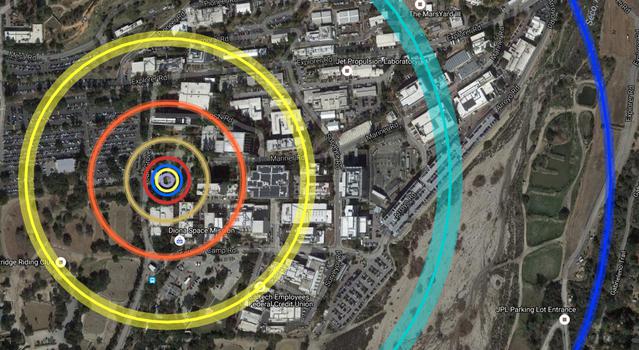
6. Calculate combined scale distance and planet size
If you are interested in a more accurate way to represent the solar system and have a lot of space (at least half a mile!) to work with, try making a model of the solar system that displays distance and planet size at the same scale. Otherwise, skip this step.
Steps:
- Download the Scale Size and Distance Spreadsheet (XLSX or CSV) or the Solar System Sizes and Distances reference guide if calculating manually.
- Decide on the diameter of Earth in your scale model. Keep in mind that a 1-cm Earth means the scale distance from the Sun to Neptune is about two miles. Consider making your scale Earth just a few millimeters across. To calculate the scale solar system, you'll need to work with proportions and ratios, as shown in this equation.

Scale Diameter / Scale Distance = Actual Diameter / Actual Distance | + Expand image
- Using the actual diameter of and distance to a planet, along with your scale diameter of Earth, you can rearrange the equation to find the unknown sizes and distances. To start, use the scale diameter you chose for Earth, and rearrange the equation as shown below to solve for the unknown scale distance from Earth to the Sun. You can calculate this by hand or create a spreadsheet function that calculates this value.

Scale Diameter (Actual Distance) / Actual Diameter = Scale Distance | + Expand image

In this example, the spreadsheet function divides the product of Earth's scale diameter (B5) and actual distance from the Sun (E5) by Earth's actual diameter (D5) using =(B5*E5)/D5 to find the scale distance from Earth to the sun. | + Expand image
- To calculate the scale diameter of the other planets, you need to rearrange proportional ratios and write equations similar to what you did in the previous step using the scale Earth diameter in your equation. By rearranging the equation below, you can calculate by hand or create a formula in the spreadsheet to find both scale diameter and scale distance for the remaining planets. Note: If you change the scale diameter of Earth in the spreadsheet, it will cause the functions to recalculate the scale values for the other planets as well.

Scale Planet Diameter / Scale Earth Diameter = Actual Planet Diameter / Actual Earth Diameter | + Expand image

In this example, the product of the scale diameter of Earth (B5) and the actual diameter of Mars (D6) is divided by the actual diameter of Earth (D5) using =(B5*D6)/D5 to find the scale diameter of Mars. | + Expand image
- Next, use the scale Earth diameter and proportional ratios to find the scale distances to the other planets by rearranging the equation below.

Scale Planet Distance / Scale Earth Diameter = Actual Planet Distance / Actual Earth Diameter | + Expand image

In this example, the spreadsheet function calculates the product of the scale diameter of Earth (B5) and the actual distance to Mars (E6) divided by the actual diameter of Earth (D5) using =(B5*E6)/D5. | + Expand image
- Repeat the previous steps for the remaining planets.
- Use a ruler, compass, string, protractor, or another tool to draw circles of appropriate sizes for each planet. You can color the circles to resemble the planets' appearances.
- Using online mapping software, such as Google or Bing maps, right-click on the location that represents the Sun (e.g., your home) and click "measure distance" to identify where the scale planets should go. Depending on the calculated size of the scale model, you may want to check with neighbors and friends to see if they can host the more distant planets in your scale model.
+ Expand image
7. Create and display your model
Now it's time to create your model! There are lots of ways you can create and display your scale solar system. With your measurements calculated, choose one of the options below, or come up with your own.

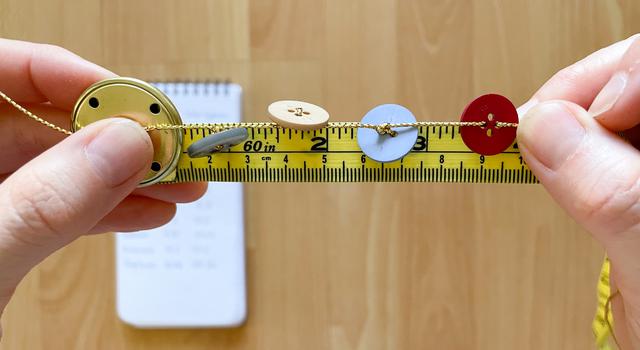
8. Make a Solar System on a String (scale distance model)
Tie colored beads onto a string to make a scale model of the distances between planets in the solar system. You can wear your model or even display it on a wall.
Materials:
- String (enough to span the distance to Neptune, plus an extra 30 cm)
- Beads, washers, or some other object to mark the distance to each planet on the string
- Calculated distances from Step 4
Steps:
- Measure and cut a piece of string about 30 cm longer than the distance you calculated from the Sun to Neptune.
- Tie a bead representing the Sun to one end of the string using a double knot. If you don't have beads, you can tie metal washers to the string, attach planet cutouts or trading cards, or simply use tape to mark the location of the Sun.
- Using the distances (in centimeters) that you calculated, measure the distance from the Sun on the string to each planet and tie a colored bead in place using a double knot. If you can, choose beads that are the colors of the planets and the Sun.
- Once you have attached all your beads or marked your planets on the string in some way, straighten out the string to see your scale solar system!
+ Expand image
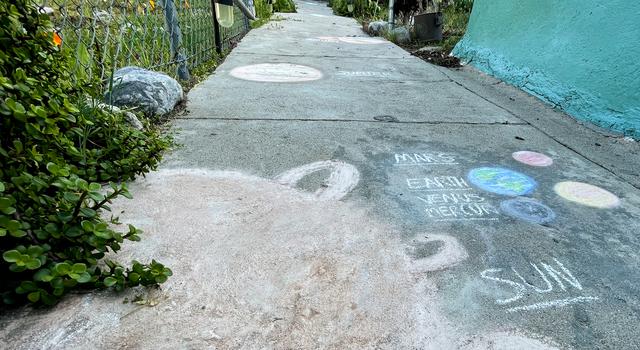
9. Solar System on the Sidewalk (scale distance and/or size model)
Use chalk to make a walkable scale model of the distances between planets and/or the sizes of planets in the solar system. Invite your family and friends to take a walk through your scale model.
Materials:
- Sidewalk chalk
- Calculated distances from Step 4 or distances and sizes from Step 6
Steps:
- Use sidewalk chalk to draw the Sun on the ground.
- Measure the distance you calculated to each planet and draw them at their scale distances.
- If you calculated the planet sizes compared with each other, measure those sizes as you draw them, giving your planets the correct diameter.
- You can draw your planets all along a single straight line from the Sun, but if you have enough space, consider drawing them at their correct distance in different spots in orbit around the Sun.
+ Expand image
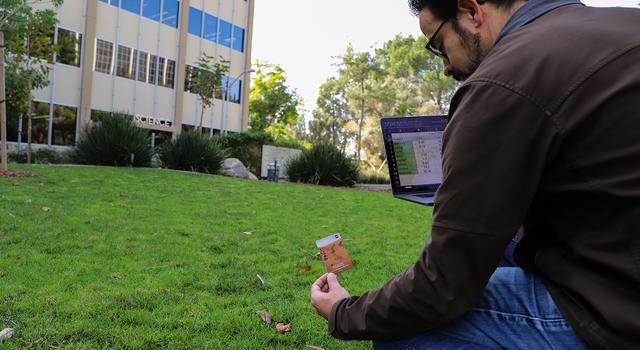
10. Solar System in the Yard (scale distance model)
Use distance markers like cones or popsicle sticks in your yard or an open area to create a scale model of the distances between planets in the solar system.
Materials:
- Popsicle sticks, cones, or other objects to mark distances
- Calculated distances from Step 4
Steps:
- Use distance markers like cones, ground stakes, or popsicle sticks to mark the locations of the planets at the distances you calculated.
- Attach drawings or cutouts of the planets to their markers.
+ Expand image
How To Create A Scale Model Of The Solar System
Source: https://www.jpl.nasa.gov/edu/learn/project/make-a-scale-solar-system/
Posted by: williamsindesur71.blogspot.com

0 Response to "How To Create A Scale Model Of The Solar System"
Post a Comment